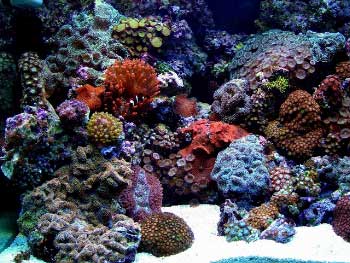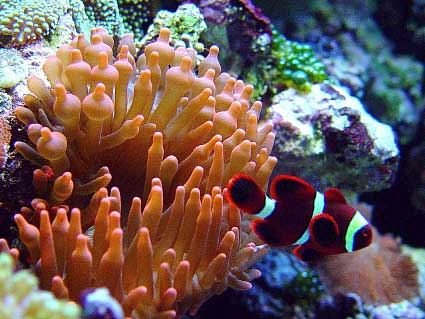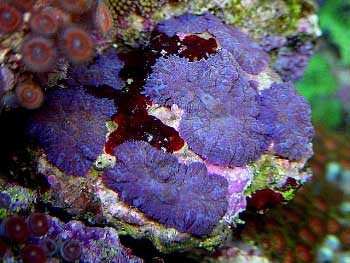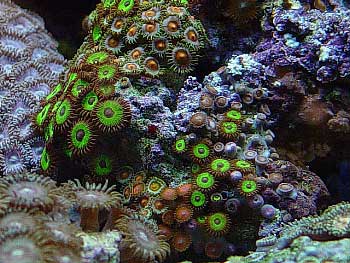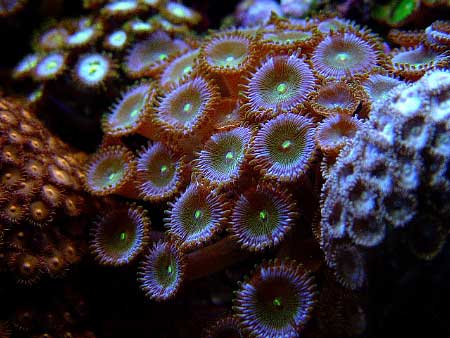MUCHO REEF'S Reef Aquarium
Introduction:
I want to take a moment to thank Reef
Central for this opportunity to share something that I truly
enjoy doing with a sincere passion. I no longer consider
reef keeping a hobby, for me, it has become a way of life.
In 1994, after viewing so many beautiful specimens at my
local fish store, I decided to sell my 29-gallon and my
55-gallon fresh water tanks and purchased a larger tank
in preparation for my first reef keeping experience. Not
wanting to rely solely on my own knowledge of marine life,
which was nothing, I began talking with everyone I could
possibly find locally on reef keeping techniques. Some informed
me that it was very difficult, yet on the contrary, many
others stated how easy it was. With that in mind, I took
the plunge. I purchased several books and I began to read
everything I could for the next month. After many years,
trials and many errors, I have found what truly works for
me. My approach to reef keeping is somewhat different than
most, not better, just different. I hope you enjoy viewing
my zoanthid and mushroom reef as much as I enjoy maintaining
it.
 |
 |
 |
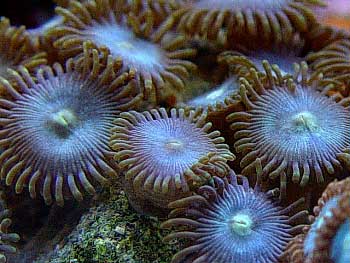 |
|
Aquarium Profile
|
•
|
70
gallon glass aquarium |
|
•
|
Dimensions:
48" L x 20" H x 18" W |
|
•
|
Approximately
125 lbs. of Fiji live rock with a few pieces of
Marshall Island live rock |
|
•
|
4
½ " aragonite sand bed |
|
•
|
Black
semi-gloss 24" tall wooden stand |
|
•
|
One
piece glass top with a 2" gap along the back
edge |
|
Left side
Right side
Center
Lighting/Photoperiod:
This lighting scheme affords the system
a good balance of mixed color. No doubt the zoanthids would
spread like wild fire with metal halides, which I’m
upgrading to with the new 180 gallon setup in September,
but the growth would get out of hand and the maintenance
would increase substantially. With the above configuration,
and the stronger
|
Lighting/Photoperiod
|
•
|
2
- 65 watt super blue actinic power compacts, 8
AM to 8 PM |
|
•
|
2
- 65 watt 10,000K power compacts, 9 AM to 7 PM |
|
blue spectrum than a normal actinic
bulb, the growth is slow enough to prune only when necessary
to maintain the natural ambiance of the ocean floor that
I've tried to reproduce. The bulbs are replaced every nine
months. For the purposes of photograpy, an extra power compact
lighting fixture was added.
Feeding:
The corals are fed twice per week, an
evening feeding and a morning feeding. At 11 PM on Wednesday
evenings, a mix of frozen Cyclop-Eez and ESV's Spray Dried
Marine Phyto Plankton are added to the left, center and
right side of the tank in the direct flow of the power heads.
On Sunday afternoon at 2 PM this process is repeated. I've
noticed some of my zoanthids actively feeding in the middle
of the night, which is why I do an evening feeding long
after the lights are off. Also, every other week, the tank
is fed one of three live foods: Artemia, Mysis
shrimp or some phytoplankton, which I get from local growers.
For the fish, a light rotation feeding
of various and assorted flake food is added once per week.
In between these occasional feedings the fish live off of
what can be scavenged off the live rock and sand bed.
Filtration:
I have used a basic live rock filtration
for this system from its inception. You're going to laugh
at the next two components, but again, no two reefs are
the same and this has always worked for me. They were left
over from my fresh water days. I don't believe in overskimming
a reef tank full of softies, so this is what has worked
for me for the past nine years or so. On the top right rear
of my tank, I run a 400 Skilter with no inserts for supplemental
surface water movement. I have an Elite air pump connected
to a wooden airstone to run the skimmer. I run the skimmer
for a full week, every other week. The low bioload doesn't
require it to run constantly in this system. On the upper
left side of the tank I have an Aquaclear 300 with a carbon
insert that is run continuously for both water clarity and
surface water movement. Both are turned off for two hours
when I feed the reef or the fish.
Maintenance:
A five gallon water change is performed
every other week. Red Sea salt is premixed with reverse
osmosis water and aerated overnight. The glass is cleaned
every morning before I go to work. Okay, stop laughing,
I know it doesn't need it but I do it anyway. I use this
brief moment to inspect everything in the system and to
see that everything is living and doing okay. All powerheads
and working components are cleaned every four months. The
carbon insert is changed once per month as well. Water tests
are performed every Saturday morning with Salifert test
kits.
|
Additives:
|
· 20 ml of ESV’s
B-Ionic Part 1 (daily)
|
|
· 20 ml of ESV’s
B-Ionic Part 2 (daily)
|
|
· 1 drop of Lugol’s
solution (daily)
|
|
· 20 ml Special
Blend (bi-weekly)
|
|
· ESV’s Strontium
(as needed)
|
|
· ESV’s Magnesium
(as needed)
|
|
I try to divide my time equally between
reef keeping and my zoanthid propagation tank. What a joy
it is to watch them reproduce time and time again. Some
have even found their way into my main system.
|
Water
Parameters
|
· Calcium: ~450
ppm
|
|
· Alkalinity:
~3.89 meq/L
|
|
· Magnesium: 1300
ppm
|
|
· Iodine: 0.06
NSW
|
|
· Specific Gravity:
~1.022
|
|
· Nitrate: 5 ppm
|
|
· Temperature:
~78° F
|
|
· pH: 7.8
|
|
· Phosphate: 0
- 0.03
|
|
Other Components:
A Natural Wave wavemaker is used with
three MaxiJet 1200 powerheads on a 30 second cycle. One
blows right to left, the other blows left to right, and
one is hidden in the very back/middle of the tank that shoots
a nice current off the front of the glass which billows
out onto both sides of the tank. I have inconspicuously
hidden them to maintain the natural appearance of my perception
of a living reef. This configuration allows for water movement
to just about every part of the reef.
Crazy Things I Do:
Every other Wednesday, I allow the tank
to remain completely dark for the entire day. The room stays
dark as well. Why? Because I believe it replicates those
stormy or overcast days which they are accustomed to in
their natural environment. On the following day, the photoperiod
returns to normal and all of the mushrooms seem to expand
like crazy for a few days after. I don’t know why.
The uptake of iodine is so great in this
system, it allows me to add one drop per day and still maintain
a safe level of iodine on a continual basis, and I would
not recommend doing this without a very reliable test kit.
Potential Reefkeepers:
If you have ever considered a relaxing
hobby that will draw you in like the vortex of a tornado,
you should seriously consider this hobby. The biggest mistake
you can make is to rush out without any forethought or planning
and purchase everything you see on the shelf. No two systems
are alike. Keeping this in mind, do some research at your
local reef store, on-line, and the bookstore etc. It will
save you an awful lot of time, money and potential devastation.
There is one common denominator among every reefkeeper I
know: PATIENCE.
Inhabitants:
|
Ricordea:
4 Orange morphs, Blue, Peach, 2 Emerald Green,
Mint Green, Red & Green, Teal, Light Green, Lime,
Aqua Blue Green mix with yellow orange nodules.
|
|
60 different Zoanthid colonies
|
|
Mushrooms
including Discosoma spp., Rhodactis spp.
|
|
2
Brain corals
|
|
Other
Invertebrates:
|
1
Yellow-back Coral Banded Shrimp
|
|
1
Arrowhead Crab
|
|
15
Blue-legged Hermit Crabs
|
|
15
Assorted Snails
|
|
4
Pacific Nassarius Snails
|
|
1
Yellow-gold Tridacna squamosa Clam
|
|
1
Bubble-tip Rose Entacmeae quadricolor Anemone
|
|
Fish:
|
1
Blue Tang (Hippo)
|
|
1
Juvenile Maroon Clownfish
|
|
1
Springer's Dottyback
|
Thank You:
To the staff and all of
the individuals who make Reef Central what it is today;
thank you once again for this humbling experience and allowing
me to share that which I love and enjoy doing so much. It
was nothing more than luck and dedication that has brought
me this far.
As a single man (hint, hint), I have
to settle for just loving my reef tank and nurturing her
with TLC. If the bottom falls out and I loose all that I
own, it won't be hard to spot me in a crowd. I'll be the
guy pushing a shopping cart with a reef tank on top and
a prop tank on the bottom.
How lucky we are to have the privilege
to maintain our own ecosystem filled with God's creatures
from the deep.
Safe reefing everyone…
The Zoo Guru
"Reefkeepers are
some of the nicest people I have ever met."
Feel free to comment
or ask questions about my tank in the forum
for the online magazine.
|













